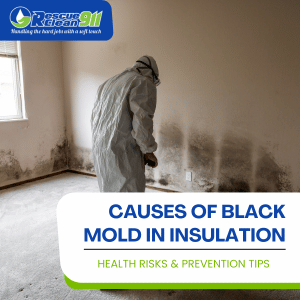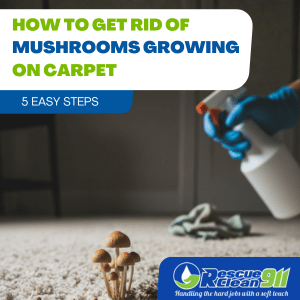Can sunlight kill mold? This question often arises among homeowners who discover musty odors or dark patches spreading across walls, furniture, or other damp areas.
The short answer is yes—but the science behind it is more complex. Sunlight, particularly its ultraviolet (UV) rays, can damage mold spores and inhibit mold growth.
However, the effectiveness of sunlight exposure depends on several specific conditions, such as moisture, humidity levels, and exposure duration.
How Can Sunlight Kill Mold?
Mold needs a food source, water, and oxygen to live. Sunlight dries out the mold, starves it of oxygen, and eventually kills it.
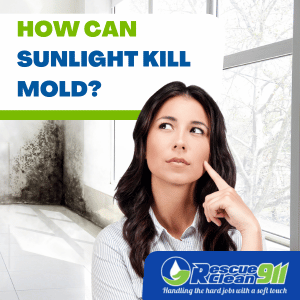 When mold spores land on a wet surface, they start to grow. Mold produces hyphae, long, thin strands of cells that branch out and form a network. The hyphae secrete enzymes that digest the food source, allowing the mold to absorb nutrients.
When mold spores land on a wet surface, they start to grow. Mold produces hyphae, long, thin strands of cells that branch out and form a network. The hyphae secrete enzymes that digest the food source, allowing the mold to absorb nutrients.
Mold needs moisture to grow, so it is often found in damp places like bathrooms, kitchens, laundry rooms, and basements. The mold can also grow on paper, wood, and carpet.
Sunlight is an effective disinfectant and will kill most types of mold. Mold cells eventually die when the sun’s ultraviolet rays damage the mold cells’ DNA. It prevents them from reproducing. The sun also provides two mold-fighting aspects – UV light and Vitamin D.
Dry conditions and direct sunlight are also hostile to mold spores, which need moisture to survive.
While sunlight is a natural mold killer, it can be difficult to expose moldy areas to direct sunlight. Sometimes, you may need to use a UV lamp or air purifier with a UV light to eliminate mold exposure.
Understanding Mold and Its Behavior
To understand how sunlight kills mold, we must first understand how mold behaves. Mold is a type of fungus that releases spores into the air. These spores land on damp surfaces—such as drywall, wood, and furniture—and start to grow.
Mold growth accelerates when humidity levels rise above 55%. This is why high humidity and poor ventilation often lead to mildew, surface mold, and even the toxic black mold known as Stachybotrys chartarum.
Mold species differ in resilience. While most varieties weaken under UV light and heat, Stachybotrys chartarum is less affected because its thick cell walls and pigmentation protect it from UV radiation.
Nonetheless, even this type can be weakened with prolonged exposure and by correcting the underlying moisture issue.
Related article: Can Mold Grow on Insulation – How To Detect and Get Rid Of It
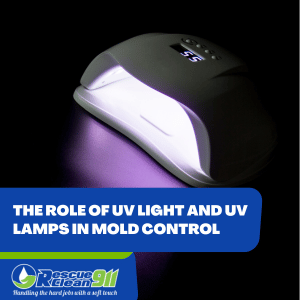 The Role of UV Light and UV Lamps in Mold Control
The Role of UV Light and UV Lamps in Mold Control
UV light plays a crucial role in mold prevention. When UV rays strike mold spores, they damage their DNA, preventing them from multiplying. This mechanism is the same reason UV lamps are often used indoors, where direct sunlight cannot reach.
However, it’s important to note that indoor sunlight is much weaker than outdoor direct sunlight. If sunlight exposure is indirect, it’s highly unlikely to eliminate mature mold colonies.
For indoor moldy areas, UV lamps can supplement natural light, especially in hidden areas or places with high humidity and limited air circulation.
The Science of Sunlight Exposure and Mold Reduction
When organic materials such as wood or drywall are directly exposed to sunlight, the heat and UV radiation inhibit mold growth by drying dampness and lowering relative humidity.
Prolonged exposure can significantly reduce the number of viable spores. This is why regularly rotating mold-prone items—such as carpets, cushions, and wooden furniture—outdoors in the sun can help prevent mold growth.
Sunlight also aids in killing bacteria and reducing mildew odors. However, it’s not a magic solution. If the underlying moisture problem isn’t resolved, mold will inevitably return even after sunlight exposure.
Proper ventilation, consistent drying, and monitoring of humidity levels remain critical for long-term mold prevention.
Related article: What Are the Symptoms of Exposure to Black Mold from Water?
Practical Tips for Utilizing Sunlight to Remove Mold
Expose items to direct sunlight
Move affected materials such as fabrics, rugs, or wooden furniture outdoors where they can be directly exposed to the sun’s rays for several hours. Direct sunlight combined with fresh air helps dry the moisture that encourages mold growth.
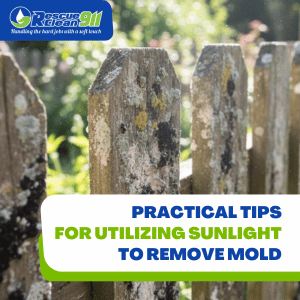 Clean after exposure
Clean after exposure
Once the mold has been sun-dried, use gentle cleaners like vinegar or baking soda mixed with water to remove mold residue. These natural solutions can effectively remove mold without introducing harmful chemicals.
Improve air circulation
Indoors, open windows and doors to allow proper ventilation. Bringing in sunlight and warm air can inhibit mold growth and prevent mold from returning.
Monitor humidity levels
Use a hygrometer to ensure indoor humidity stays below 50%. High humidity can encourage mold growth even in areas exposed to sunlight.
Use UV lamps when necessary
In spaces without direct sunlight—like basements, bathrooms, or behind furniture—install UV lamps designed to inhibit mold growth and kill mold spores in the air.
The Benefits of Using Sunlight to Kill Mold Growth
Sunlight is a natural disinfectant that can be used to kill mold. Sunlight exposure also helps to dry out wet areas, which in turn helps prevent mold growth.
There are several ways to use sunlight to kill mold.
One way to remove mold is to place infested items in direct sunlight.
Another way is to use a UV light to kill mold.
UV light can penetrate surfaces and kill mold spores. This makes it an ideal method for killing mold in hard-to-reach places.
Sunlight exposure can also help to prevent mold growth in the future. When mold spores are exposed to sunlight, they are less likely to survive and grow. This means that areas that are regularly exposed to sunlight are less likely to experience mold growth.
Overall, using sunlight to kill mold is an effective and natural way to get rid of this fungus. It is also a preventive measure that can help keep mold from returning in the future..
Related article: Who Pays for Mold Remediation?
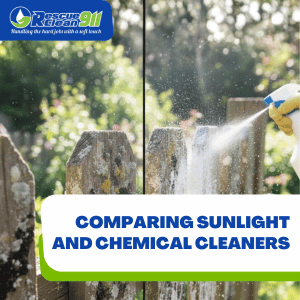 Comparing Sunlight and Chemical Cleaners
Comparing Sunlight and Chemical Cleaners
Many homeowners wonder whether it’s better to use bleach or sunlight to kill mold. Bleach is not recommended and cannot effectively remove mold on non-porous surfaces. It doesn’t penetrate deeply and may leave spores alive inside porous materials. It also releases fumes that can irritate the respiratory system.
Sunlight, on the other hand, relies on UV radiation and heat—both natural forces that dry out and sterilize the area affected without introducing toxic substances.
However, sunlight requires sufficient exposure duration and direct contact with the mold to work effectively. Both methods can complement each other when combined with proper ventilation and consistent moisture control.
The Limitations of Sunlight for Mold Removal
While sunlight can significantly reduce mold, it’s not always a complete solution. Deep mold colonies inside porous surfaces such as drywall, carpets, or wood can survive beneath the surface even after extended exposure.
UV rays cannot fully penetrate thick or dense materials, so physical cleaning is often necessary to remove mold completely.
Additionally, not all days offer ideal sunlight intensity. Cloudy weather or short winter days can reduce UV radiation, decreasing effectiveness. To compensate, homeowners can use artificial UV lamps or dehumidifiers to maintain dryness and inhibit mold growth indoors.
Using a humidifier incorrectly can increase indoor humidity levels and create ideal conditions for mold growth, making it crucial to use and maintain these devices properly.
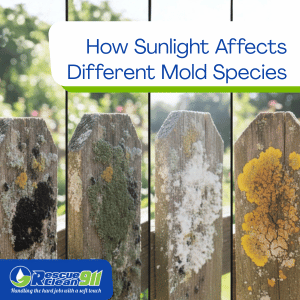 How Sunlight Affects Different Mold Species
How Sunlight Affects Different Mold Species
Different mold species respond differently to UV radiation. Lighter molds tend to die more quickly under UV rays, while darker varieties—like black mold—are more resistant due to their pigmentation.
Stachybotrys chartarum, for instance, is known for its resilience and ability to survive under moderate sunlight exposure.
Despite this, prolonged exposure to strong sunlight can weaken even resistant species. Utilizing sunlight strategically, along with drying agents like baking soda or dehumidifiers, can significantly reduce mold presence and prevent future outbreaks.
The Importance of Addressing Moisture and Ventilation
No matter how much sunlight you use, if moisture persists, mold will return. Moisture is the primary factor that allows mold spores to germinate and spread. Maintaining proper ventilation, repairing leaks, and ensuring dry conditions are essential to prevent mold growth.
Opening windows regularly allows sunlight and fresh air to circulate, reducing the accumulation of dampness and dust. Sunlight also raises indoor temperatures slightly, promoting evaporation from damp surfaces and further discouraging mold growth.
If your home has porous materials like wood or drywall, ensure they remain dry. Mold can penetrate deeply into these surfaces, making removal harder and potentially leading to structural or health issues, including allergies and respiratory issues.
Related article: What Happens If Mold Is Found During Home Inspection?
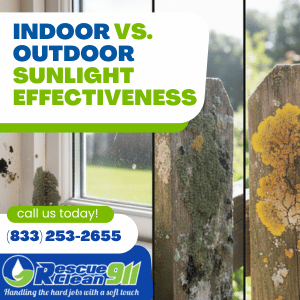 Indoor vs. Outdoor Sunlight Effectiveness
Indoor vs. Outdoor Sunlight Effectiveness
Outdoor sunlight is stronger than indoor light due to the full spectrum of UV rays it provides. Indoor light, filtered through glass or curtains, loses much of its UV radiation and therefore cannot kill mold as effectively. For best results, bring moldy items outside whenever possible.
That said, utilizing sunlight indoors still contributes to maintaining lower humidity and better air quality. Sunlit rooms tend to stay warmer and drier, conditions that inhibit mold growth and prevent mold spores from spreading.
The Bottom Line!
Sunlight’s UV rays damage mold DNA, dehydrate damp areas, and create an environment where mold cannot thrive. Still, sunlight requires direct and prolonged exposure, and underlying moisture problems must be resolved.
If mold has already spread or penetrated deeply into porous materials like drywall or wood, professional help may be necessary. Rescue Clean 911 specializes in safe, science-based mold removal.
Our experts use advanced UV light systems, moisture control strategies, and proven cleaning techniques to effectively remove mold and prevent its return.
Don’t let mold compromise your health or home. Contact Rescue Clean 911 today for a complimentary consultation and expert evaluation.
With our help, you can enjoy cleaner air, healthier living spaces, and a mold-free environment—because, yes, can sunlight kill mold, but professional prevention ensures it stays gone for good.

